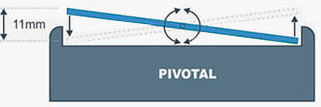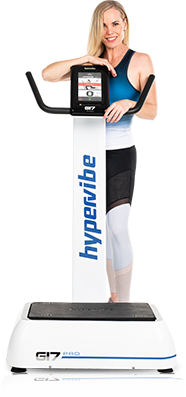There have been few occasions where a Lineal and Pivotal machine were compared in the same study using the same settings. In each case however the results appear to be the same – Pivotal produces greater muscle activation and less head vibration.
In a 2006 study conducted by NASA (National Aeronautics and Space Administration) a leading Lineal and leading Pivotal machine were both used in the same muscle performance experiment and the results of each compared.
3
According to the researchers, the conditions for each platform were the same:
- Same Frequency (30Hz)
- Same Amplitude (4mm)
- Same test subjects
- Same exercises
The Result:
“[Muscle] responses were significantly greater during rotational vibration (Pivotal) than vertical vibration (Lineal).”
In 2012 at the Institute of Sport and Science in Germany, researchers again took a Power Plate (Lineal) and Galileo (Pivotal) and measured a number of different muscles for their response to the same vibration frequency and amplitude on both machines.
The Result:
“Neuromuscular activity during SV (Pivotal) was enhanced compared to SyV (Lineal)”
The following graph shows these results with the dark bars being Pivotal and the hollow bars being Lineal. The higher the bar, the greater the amount of muscle activity. Pivotal produced on average 133% more muscle activity.
 In Pivotal vibration machines, the platform you stand on tilts around a central pivot point like a see-saw. The left and right sides alternate up and down while the centre remains fixed.
You can change the total distance your feet move up and down (other terms include ‘displacement’and ‘peak-to-peak amplitude’) by moving them either closer or further away from the centre. The maximum possible distance varies from one machine to another but most are generally close to 10mm.
In Pivotal vibration machines, the platform you stand on tilts around a central pivot point like a see-saw. The left and right sides alternate up and down while the centre remains fixed.
You can change the total distance your feet move up and down (other terms include ‘displacement’and ‘peak-to-peak amplitude’) by moving them either closer or further away from the centre. The maximum possible distance varies from one machine to another but most are generally close to 10mm.


 A Lineal vibration platform remains horizontal at all times with the entire platform moving up and down by the same amount.
Lineal vibration platforms typically have small peak-to-peak Amplitudes of 2mm or less. Some have multiple amplitude settings eg. low (1mm) or high (2mm).
A Lineal vibration platform remains horizontal at all times with the entire platform moving up and down by the same amount.
Lineal vibration platforms typically have small peak-to-peak Amplitudes of 2mm or less. Some have multiple amplitude settings eg. low (1mm) or high (2mm).




